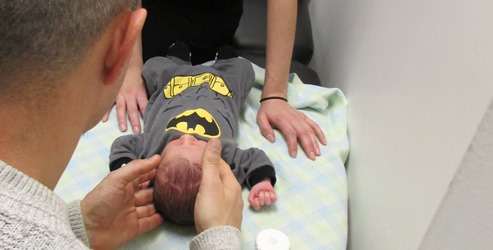Infantile Colic
Infantile colic can be as troublesome for the parent as the child experiencing the condition. Characterized by a multitude of symptoms, the child suffering from infantile colic does not usually respond to simple comforting methods and exhibits periodic fussiness that can last over hours and days.
In many cases the infant appears to be in pain and will pull up his/her legs. At times the child’s abdomen will be hard and distended. Occasionally the passage of flatus will give relief, yet these attacks may last for hours. To make matters more complicated, this condition rarely responds to traditional health care. This leaves many parents troubled as an infant’s episodes of crying and fussiness persist.
A healthy approach
Two chiropractic studies relating to infantile colic are of particular interest. The first study was done by a group of Danish chiropractors who revealed positive results when spinal adjustments were given to a group of colicky infants. 1 A second study involving a group of 316 infants diagnosed with colic reported 94% successful resolution within the first two weeks of chiropractic care.2
Although chiropractic care does not treat the symptoms of colic specifically, Doctors of Chiropractic have found after adjusting hundreds of babies that most will respond within the first few weeks.3 Why does chiropractic work when other methods fail? It’s simple really. Nerve supply is vital to the proper function of every system of the body, including the stomach, intestines, and other abdominal organs. Any vertebral subluxation causing interference to the nerves in this area could adversely affect gastric function and result in discomfort, gas and other colic symptoms.
What is a vertebral subluxation?
A subluxation is a neurological disturbance caused by a nerve that is not functioning properly. The body depends upon the free flow of nerve communication – from the brain, through the spinal column, and to all parts of the human body – in order to govern itself and all of its functions. The interruption, blockage, or aberration of this flow of information can lead to serious health complications. Conversely, the removal of such interference has been shown to have important health benefits.
All body functions are controlled by messages from the brain sent through the nerves. When nerves become stretched, twisted, or “pinched”, this vital communication system of the body id disrupted. As a result one or more functions of the body may begin to fail. As the body weakens, health declines and if uncorrected, the body will ultimately give in to sickness and disease. This is how vertebral subluxation can lead to all kinds of neurological, emotional and physical disorders such as infantile colic. The Doctor of Chiropractic specializes in the detection and correction of subluxations. This is done by laying his/her hands on the back and gently lining up the vertebrae into their natural position. This process may take weeks or months, depending on the extent of misalignment. As the subluxations are reduced, however, nerve supply communicates more effectively throughout the body and healing may begin to take place. As the body heals, the symptoms of dysfunction and disease diminish.
Conclusion
As the infant with colic responds to chiropractic care, parents usually note that the child sleeps for longer periods without fussing, and requires less comforting.4 As a parent you can do your part to help your child by keeping your child’s appointments, and following your Doctor of Chiropractic’s instructions. Remember, healing takes time. Chiropractic is a natural science in that it neither stimulates nor inhibits body function, but instead gradually allows normal body function to take place once again.
As chiropractic helps to restore normal function in your child’s nervous system, your infant’s digestive tract and other related organs have a better opportunity to receive LIFE (nerve supply) from the brain, bringing it back to full normal potential. The result is a content baby and a happier you.
REFERENCES
1. Klougart, N.; Nilsson, N.; Jacobsen, J.: Infantile Colic treated by chiropractors: A prospective study of 316 cases. J manipulative Physiol Ther 1989; 12:281-288.
2. Netter, F.: The Ciba collection of medical illustrations. Volume I Nervous System, part 1 Anatomy and Physiology. 1986.
3. Nilsson, N.: Infantile colic and chiropractic, Euro J. Chiro 1985; 33:624-665.
4. Peet, J.B.: Infantile Colic, Baby Talk Newsletter, Volume 2, Nol.3. 1993.
5. Walton, E.V.: Chiropractic Effectiveness with Emotional Learning Behavioral Impairments. International Review of Chiropractic, 29:2-2,21-22, September, 1975.
6. Winsor, H., M.D.: Sympathetic Segmental Disturbances-11; The evidence of the Association in Dissected Cadavers, of Visceral Disease with Vertebrae Deformities of the Same Sympathetic Segments, Medical Times, 49:1-7, November 1921.






